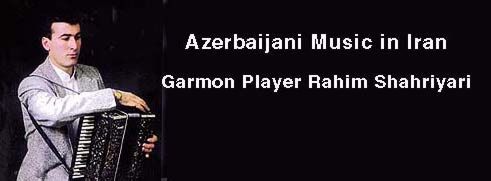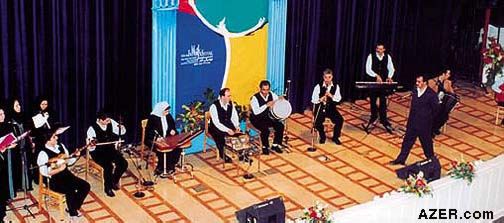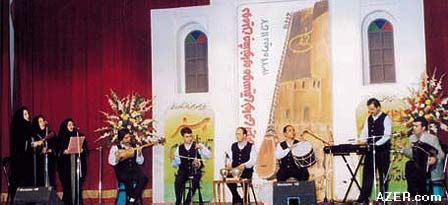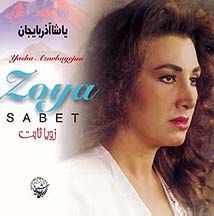|

Spring 2001 (9.1)
Pages
52-56 |

Samples of Rahim's garmon music and the Araz Ensemble are
available at AZER.com. Click on MUSIC.
Innovation comes
in all shapes and forms, but invariably the arts are among the
first to signal a change in social attitudes. That's certainly
the case with Azerbaijani music these days, especially as it
is being performed in Iran. Rahim Shahriyari (1971- ) is among
those at the forefront of the Azerbaijani music scene in Iran.
He composes, sings and plays the garmon - an accordion-like instrument
traditionally used in Azerbaijani folk music. And since the Azerbaijan
Republic gained its independence, Rahim has gone to Baku on several
occasions to bring back new music and lyrics. He and the group
he helped form, the Araz Ensemble, have been dazzling Iranian
audiences with their performances of Azerbaijani music, which
these days includes Azerbaijani folk dances.
To best understand the significance of Rahim's efforts, it's
important to know that up until the Islamic Revolution took place
in Iran in 1979, there were very few opportunities to perform
Azerbaijani music there, despite the fact that more than one-third
of the population (at least 25-30 million people) is of Azerbaijani
descent. Since 1998, when President Khatami came to power, Azerbaijani
music has fared much better. We asked Rahim about the impact
of the garmon on his own life as well as the growing popularity
of Azerbaijani music in Iran.
_____
Azerbaijani Rahim Shahriyari lives in Tehran and even though
he's only 30 years old, he's already an important figure in the
development of Azerbaijani music - a genre that is becoming increasingly
popular in Iran.

Above: Recently the Iranian
government has become more open in allowing Azerbaijanis to perform
their own music in Iran. (There are an estimated 25-30 million
Azerbaijanis living in Iran.) Here Rahim Shahriyari and his group,
Araz Ensemble, perform in Tehran. Women (wearing head scarfs
here) are also allowed to perform but not as featured soloists
if men are present in the audience.
Despite the fact that there is a substantial population of Azerbaijanis
living in Iran, up until the Revolution [1979] Azerbaijani music
was rarely heard in public music venues. Rahim says that these
days the openness toward Azerbaijani music has increased even
more. For instance, on radio stations, he can hear his own music
being played daily, even though all of the programming is in
Persian.
Azerbaijanis are not the only ones who tune in to Azerbaijani
music. "For the last six years that I've lived in Tehran,
I've been giving three or four major concerts a month,"
Rahim says. "We usually attract an audience that's about
half-Azerbaijani and half-Persian. Not so long ago when we gave
a concert in Gorgan, a city in the northern part of Iran, it
was mostly all Persians who attended."
According to Rahim, it doesn't seem to matter that most Persians
don't understand the words to the Azerbaijani songs. "I
remember once I was singing at a ceremony and this Persian woman
was trying to sing along with me to one of Tofig Guliyev's most
popular songs - 'Sana da Galmaz' (Your Beauty Won't Last Forever).
[For the musical score and words to this song, made popular in
the 1960s-1970s, see Azerbaijan International (AI 3.4), Winter
1995]. Even though she couldn't pronounce the words very well,
she really made a great effort to sing along with me. It just
goes to show how much Azerbaijani music is appreciated."
Araz Ensemble
Several years ago, Rahim created the Araz Ensemble, which now
has 17 musicians including dancers and singers. The group takes
its name from the Araz River, which divides what is known as
Northern Azerbaijan (Republic of Azerbaijan) and Southern Azerbaijan
(now Iran), a political division that occurred in the early 19th
century with a treaty at the conclusion of war between Russia
and Iran.

Above:
The Araz
Ensemble recently performing in Iran. Note the women's choral
group which accompanies a male soloist. However, during Novruz
celebrations in the United States in 2000, Zoya Sabet, an Iranian
singer (below), who lives in Los Angeles, was the featured soloist
with the Araz Ensemble. Their concert also featured songs from
various other ethnic groups living in Iran as well. Zoya learned
the lyrics for several Azeri songs.
The musical ensemble includes five women, which in itself is
quite remarkable. Just a few years ago, women were not allowed
to perform onstage at all, despite the fact that during the Reza
Shah's time (up until 1979), there were many women performing
as soloists, for example, Googoosh [See AI 8.3, Autumn
2000]. These last few years, women have begun performing in groups,
not in solo performances yet, for women audiences. While some
Persian groups now have both men and women performing as well
as singing together, Rahim says that Araz was the first Azerbaijani
ensemble to do so. The Araz women include four Azerbaijani singers
and one woman who performs on the canon, or santur - an instrument
with strings that are tapped with hammers rather than plucked,
like a dulcimer. The Araz female singers are also members of
the Iran Symphonic Orchestra.
The female chorus joins Rahim in singing Azerbaijani songs like
"Yasha Azerbaijan!" (Live Azerbaijan!) "Before,
nobody would have dared to recognize the Azeri language or Azerbaijani
culture," Rahim says. "You know, it takes guts to sing
about Azerbaijan, about its language and its nation in Iran.
In the past, you could never have said, 'Yasha Azerbaijan! Yasha
manim khalgim!' (Live Azerbaijan! Live my nation!) Now we sing
such songs openly. I'm happy that Baku and Iranian musicians
can come together and sing 'Yasha Azerbaijan!' That's a revolution
in itself."
In 1998 and again in 1999, Rahim and some of the members of the
Araz group performed in concerts in the United States with featured
female soloist Zoya Sabet. Though Persian, Zoya learned the eight
Azeri songs that Rahim taught her for the concert, which also
featured folk songs from various other native languages in Iran.
A CD called "Yasha Azarbayejan" has since been released
with the Azeri songs; it was produced by Parviz Gharib-Afshar
of Shiva International Enterprises.
  Dancers are also a new
twist to the Araz ensemble. "This year, 22 years after the
Iranian Islamic Revolution, we've now been able to add 12 Azerbaijani
dancers," Rahim explains. "Some of them are young kids,
but others are professional dancers who used to dance 30 years
ago. They didn't dance for many years because it was prohibited.
But I managed to get the government's permission to let them
dance on stage again." Dancers are also a new
twist to the Araz ensemble. "This year, 22 years after the
Iranian Islamic Revolution, we've now been able to add 12 Azerbaijani
dancers," Rahim explains. "Some of them are young kids,
but others are professional dancers who used to dance 30 years
ago. They didn't dance for many years because it was prohibited.
But I managed to get the government's permission to let them
dance on stage again."
Left: Iranian singer Zoya
Sabet recently produced a new CD entitled "Long Live Azerbaijan"
(Yasha Azarbaijan), which contains eight Azerbaijani folk songs.
The performance took place at the ten-day annual festival commemorating
the establishment of the Iranian Revolution on February 7-16,
2001. This year 90 ensembles participated, including groups from
India, Georgia, Germany, Italy and Spain. Rahim's group rehearsed
nine months in anticipation of the event. Other Azerbaijani groups
that performed did not have dancers or women. "Newspapers
were writing about the Araz Ensemble as a big hit at the Festival,"
Rahim says. "Each group was allotted three days to perform,
but they gave us six days."
Another new trend worth noting is that lyrics now refer to love
and relationships between men and women. Before, singers used
to sing about nature, native land and such things.
Mixing Azerbaijani traditional musical instruments with symphonic
and Western instruments is new, too, as is having musicians from
North and South Azerbaijan perform together in Iran. During a
recent festival, Rahim's group performed with two brothers from
Azerbaijan: guitarist Chingiz Sadikhov and drummer Aflan Sadikhov.
The group also invited a clarinet player from Baku - Abdulagha
Huseinov. "That was the first time that a guitarist had
performed with Azerbaijani musicians in Iran," Rahim says.
"We also had the percussionists play a duet with Housein
Afshari, one of the drummers in our group. It was another first
for Azerbaijani music in Iran."
At this same festival in Tehran, another musician from Azerbaijan,
Zulfugar Rajabov, joined the ensemble, playing percussion on
different-sized tea saucers and giving a phenomenal performance.
"People were amazed," Rahim says. "It was the
first time that Iranian people had heard Azerbaijani music played
on tea saucers! I invited Zulfugar to the festival to demonstrate
the broad range of Azerbaijani music that is available."
Rahim usually sings pop songs himself, but he always invites
some mugham singers to perform more traditional modal pieces.
Some of the music that Rahim performs is his own compositions.
For the lyrics, he looks to some of the Azerbaijani poets living
in Iran, such as Ali Huseynzade (Dashgin) or Mahmud Dastpish
(Valeh).
One of the most recent performances took place in February of
this year at the Tehran Mudiriyyat University, where the Araz
Ensemble gave a concert for about 500 Azerbaijani students. University
officials had seen them perform at the Festival and invited them
to the university. Some of the students came up after the concert
and told Rahim: "Today, we discovered that we are Azerbaijanis
and that we must be proud of it." He was so glad that some
of the students were being affected by the music.
People often applaud the power of music to heal. The therapeutic
power of music has clearly been a powerful influence in Rahim's
life. "I lost my father when I was seven years old, so my
youth was really difficult, especially until music entered my
life at age 18. Life was tough and I had to study, work and earn
my own money. I kept looking for a way to express my grief because
I felt like my heart was going to explode. It was the garmon
that took away my sadness.
"I used to watch garmon players as they held the instrument
against their chests. Opening and closing those bellows, sometimes
quickly, sometimes slowly. Then lifting the instrument up high
and bringing it down low. That's how my heart had felt from childhood
- racing, going slow, sometimes feeling exuberant, sometimes
depressed. That's why I decided that the garmon was the instrument
for me. Of course, I liked other instruments, too, but I thought
that the garmon could best express my heart's grief. Once I started
playing the garmon, I could get free of that heavy grief. The
more that I played, the more my sadness left me."
A Late Start
Rahim grew up in Tabriz, one of Iran's largest cities, which
is mostly populated by Azerbaijanis. His grandfather came from
the "other side", he explains, meaning Baku. Borders
between the two countries were quite open until the late 1920s,
when Stalin began the process of isolating the Soviet Union from
the rest of the world, and many Azerbaijanis fled south to Iran.
Rahim says that his family wasn't particularly musical. "My
grandfather had a very good voice," he recalls. "So
did my father. But they were never involved professionally in
music. At 15, I took first place in Tabriz in a singing contest
for young people. But I didn't start doing music professionally
until I was 18, in 1989 when I started playing the garmon. At
the university I studied accounting. Now when I look back, I
wish I'd spent those years studying music instead."
After returning from the army at the conclusion of the Iran-Iraq
war in 1989, Rahim bought his own garmon and couldn't keep his
hands off of it. He put himself through private music school
for three years and practiced as much as eight to nine hours
a day. He studied with two different garmon masters: Yusif Azimzade
from Tabriz and Vagif Asadov from Baku. "It was my instructor
from Baku who taught me proper fingering technique," Rahim
says. "I had learned the wrong way.
"In Iran, we don't have music conservatories like the Baku
Music Academy," he explains. "I often tell people that
I learned to play the garmon at Azerbaijani weddings. Actually,
you can learn a lot from them. At a typical wedding, I often
play for eight hours - about 150 different songs. Since there
are so many requests for favorite pieces, it requires a broad
repertoire."
Contact with Azerbaijan
Rahim has visited and performed in Baku on several occasions
since Azerbaijan became independent (late 1991). He remembers
how excited he was to meet famous Azerbaijani musicians for the
first time: "When tar player Ramiz Guliyev, singer Arif
Babayev, kamancha player Munis Sharifov and tar player Firuz
Aliyev were in Tehran, they heard me play the garmon. They were
surprised. 'We didn't know there were any garmon players in Iran,'
they told me.
"In fact, the first time that Ramiz Guliyev heard me play
the garmon, I was 23 years old. He told me he thought that I
had been practicing the instrument for at least 20 years - actually,
it had only been about five."
Since that time, Rahim has performed in several concerts with
well-known Azerbaijani musicians such as Ogtay Hajiyev, Behbud
Agakhishiyev, Mukhtar Novruzov and Hilal Mammadov. He and his
garmon have appeared in Baku, Turkey and the United States. After
Noruz (New Year's Day, March 21st) this year, he's planning to
take ten musicians from Iran and ten from Azerbaijan to tour
Sweden, Norway, Holland and Germany.
The last time Rahim visited Baku, he says, he was concerned about
some of the trends that he saw taking place there. He was disappointed
to discover that Azerbaijanis were listening to Turkish and Western
pop music rather than Azerbaijani music; he's concerned that
they will lose their own music.
Recent Recordings
Rahim has already recorded several CDs of his music. In March
2001, a CD of garmon music called "Ipak"(Silk) was
released in Iran. Two of the songs on the CD are his compositions;
the others are Azerbaijani folk dance music, such as "Tarakama".
Two other CDs have been released in the United States, including
"Galmadin" (You Didn't Come), a reissue of a CD of
garmon melodies that was released in Iran seven years ago. Soon
to be released is another CD, called "Bayaz Gejalar"
(White Nights), produced by ParsVideo. This CD features pop songs
that used to be popular in Baku, such as "Ana" (Mother),
"Baghlar" (Gardens) and "San Allah Gal" (For
God's Sake, Come).
Rahim has been working on two more pop CDs, one of which is called
"Aghlama" (Don't Cry) and contains two songs devoted
to Karabakh. Another CD, "Shan Mahnilar" (Cheerful
Songs) is soon to be released. It will feature Murtuza Barjasteh,
a Persian singer living in Los Angeles. Rahim taught him the
11 Azeri songs that are on the CD. Rahim himself is part of the
chorus, along with women singers.
The energetic Rahim has high hopes for his music - not only in
Iran, but also Azerbaijan and other places in the world. "In
the future, I would like to bring musical instruments together
from different countries. I would have an American playing saxophone,
a Spaniard playing guitar, a Persian playing piano and an Azerbaijani
playing garmon. I would have an Azerbaijani singer performing
next to an Italian - all sorts of combinations. Perhaps, that's
how we can save Azerbaijani music and make it known widely throughout
the world. That's my dream."
Rahim Shahriyari was interviewed by Editor Betty Blair
along with staff members Vafa Mastanova and Farida
Sadikhova. Samples of Rahim's garmon music and the Araz Ensemble
are available at AZER.com. Click on MUSIC.
For more information about father and son tar players Ramiz and
Ayyub Guliyev, see "Sing Tar,
Sing"
in AI 7.4, Winter 1999.
_____
From Azerbaijan
International
(9.1) Spring 2001.
© Azerbaijan International 2001. All rights reserved.
Back to Index
AI 9.1 (Spring 2001)
AI Home
| Magazine Choice | Topics
| Store
| Contact
us
|




